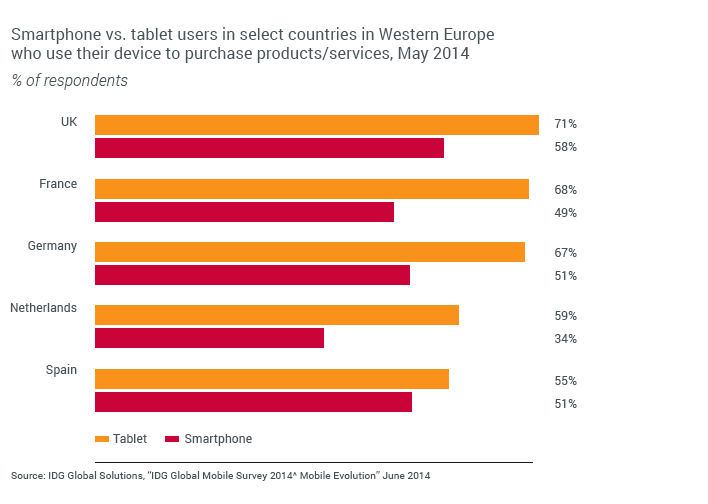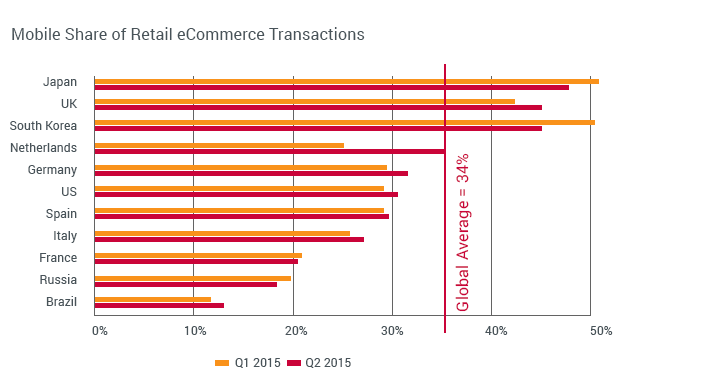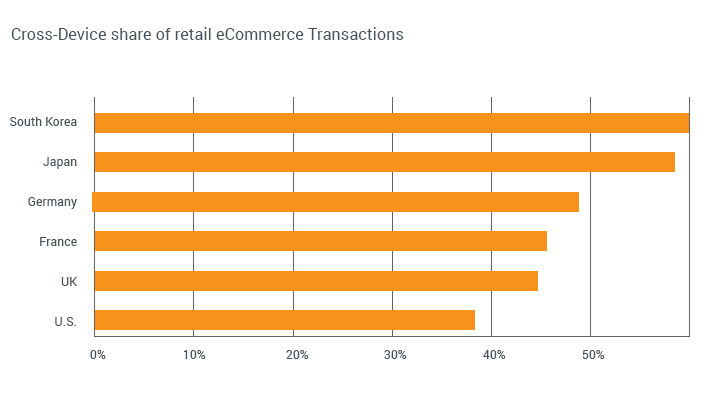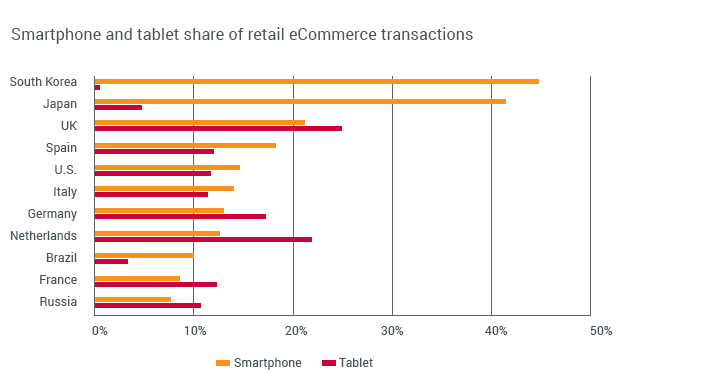mCommerce continues to grow. The biggest users are the people of Japan, the United Kingdom, South Korea, Netherlands, Germany. Due to holiday effect, mCommerce growth rate is slower in Q2. Nevertheless, mCommerce transactions total to more than 30% of all eCommerce transactions globally. This figure was announced in a recent mCommerce report by Criteo, online marketing company, and is based on the data from 1.4 billion of transactions. This trust-worthy base singles out certain mCommerce experiences and modes of shopping behavior in retail.
Due to holiday effect, mCommerce growth rate is slower in Q2. Nevertheless, mCommerce transactions total to more than 30% of all eCommerce transactions globally. This figure was announced in a recent mCommerce report by Criteo, online marketing company, and is based on the data from 1.4 billion of transactions. This trust-worthy base singles out certain mCommerce experiences and modes of shopping behavior in retail.
Below is a look at the mCommerce trends and their benefits for retailers.
Trend 1. Mobile-optimized websites deliver more mobile sales.
On April 21, 2015 Google introduced a new mobile search algorithm. The new algorithm favors mobile-optimized websites over non-optimized ones. Since Google now is getting more queries from people using mobile devices than it does from people browsing the Web on PCs in 10 countries, incl. USA and Japan, retailers could lose a significant amount of search traffic and potential customers. Launching mobile-optimized websites seems to be an emergency measure for retailers.
In 2015, Criteo partnered with Digiday to understand perspectives and trends in retail. One of the findings of this Retail Mobile Pulse Survey states that 82% of retail executives see mobile-optimized sites as a high priority.
Mobile-optimized websites accommodate smaller screens: the navigation bar usually turns into a one-click drop-down menu, and the elements of the page fall in line one-by-one as the user scrolls down.
Retailers look to mobile-optimized websites to secure smooth experience of browsing products and comfort in adding them to basket due to bigger buttons/links. This is what makes difference for customers who tend to more readily convert while experiencing a mobile-optimized site. The latest study of mCommerce in Q2, 2015 says that the conversion rate of the mobile-optimized websites totals to 3.4% versus 1.6% of non-optimized ones in the U.S.
Trend 2. Cross-device behaviour is more common.
Cross-device shopping in constantly increasing. The fact of the present-day mCommerce, that, perhaps, will surprise you now is that 40% of research and purchasing decisions take place on cross-device, i.e. on smartphones, tablets and desktops. Smartphones are considered to be used in the middle of the shopping process, while tablets are used for product search and for a final purchase.
This trend is a challenge how retailers can benefit from it. It is harder to target customers on a particular device, that’s why many of them have already jumped on the omnichannel bandwagon. Omnichannel shopping experience means sales through a website, iOS and Android mobile app development for smartphones and tablets as well as contactless payment platforms.
Trend 3. Tablets are beating smartphones in Europe and Russia, while smartphones are the dominant worldwide. Both are shrinking desktops.
Software development for mCommerce is a battlefield of smartphones and tablets. There is a significant change in the ratio of the use of smartphones and tablets in different countries.
Tablets overtake phones despite the fact that there are fewer tablets. The phenomenon occurs in Western Europe. In 2014, IDG Global Solutions found that tablets users in France, Germany, the Netherlands, Spain, and the UK make purchases with their devices more often than smartphones users. Tablets are preferred for transactions because large screens make it easy to zoom detailed product views, browse the web, and search.

Figure 3: Smartphone vs. tablet Cross-Device Share of Retail eCommerce Transactions
Source: |IDG Global Solutions, May 2014
The situation is similar in 2015. Please, compare:
However, iOS and Android mobile app development for smartphones is dominant in Japan and South Korea. As you can see in the picture, more than 40% of mCommerce transactions are made with smartphones in these countries. Summarily, the smartphone is the dominant device globally.
Taking into consideration high rates of mobile adoption, the usage of desktops is shrinking.
For retailers, mCommerce mobile software development often becomes the closest way to reach customers. Android and iOS mobile app developent is growing. Retailers (trusted brands are not exception to the rule) augment their business with their branded software development for mCommerce, namely mobile apps.
Mobile apps drive up to 50% of mCommerce for retailers, Criteo’s Q2 mobile commerce report says. This is a good prerequisite for the next trend in mCommerce mobile software development.
Trend 4. Retailers take advantage of iOS and Android mobile app development and promote their mobile apps.
iOS and Android mobile app development is a way to engage customers and retain them. Software development for mCommerce offers more than just a transaction. Mobile apps for retailers enable improved customer experience. Detailed product overviews, other customers’ product reviews, relevant videos matters. On the other hand, mobile software development for mCommerce can be effectively used for special offers, discounts and other loyalty programs. Consequently, iOS and Android mobile app development converts at a higher rate. Criteo says that in the U.S. shoppers view more than 3 times the number of products on apps than on mobile browsers due to a better experience.
Besides, mCommerce mobile software development enables good analytics capabilities for retailers. iOS and Android mobile app development gives retailers a better understanding of customers and their needs and allows them to make data-driven business decisions.
Trend 5. Retailers look to integrate with the contactless payment systems.
Near-field communication (NFC) technologies have been gaining momentum because they are changing the way customers pay for products. App development companies offer special apps to allow quicker checkout and convenience when consumers do not have to carry cash or a credit card.
It would be fair to say that retailers are pretty slow to integrate NFC systems into their stores. Nevertheless, it is obvious that contactless payment technologies enable smoother customer experience. With the release of host card emulation (HCE) technology, retailers can bring convenient features to their customers – loyalty point accumulation, secure payments and single-tap coupon redemption. On a commerce scale, brands can leverage the technology to drive revenue with targeted marketing efforts and cut costs.
We do not predict that the quick adoption of contactless payment platforms will take place overnight. It will co-exist with traditional payments but will become a reality in a few years. Nowadays, contactless payment services find wide usage in such technologically-savvy countries as Japan and South Korea.
Trend 6. iOS and Android mobile app development for retail use the advantages of social media.
Facebook, Instagram, Twitter, etc. continue to prove their importance for retailers. The latter take benefit from advertising and promotion of their brands in networks. In 2013, there was an interesting survey in the U.S. One of its surprising findings was that 90% of customers admitted that their buying decisions were influenced by online reviews. In other words, reading reviews about retailers, ratings of products or critiques greatly sway the perceptions of potential customers. Software development for mCommerce provides consumers with possibilities to share their recent purchases with a single click, include the use of relevant hashtags and their share reaches far beyond their network. It all makes social networks into a powerhouse for retailers.
In conclusion, all the mentioned trends cover different aspects of mCommerce but have something common: mCommerce as well as retail software development as its integral part are dependent on customer experience and are subject to change the way consumers shop.
Industries and Technology Areas:
Industries: retail
Technology Areas: software development services, mobile app development services
Related Cases: Exploring Innovative Retail and eCommerce Solutions
Retail Investors Platform Development
Matchmaking Platform for Artisan Retailers in Germany
Predictive Analytics for Forecasting Retail Demand
Gamification Solution for Retailers Worldwide
Seamless Integration for Enhanced Efficiency
Revamping eCommerce Platforms for Better Performance
Empowering Businesses with eCommerce Website Builders
Optimizing Online Consumer Electronics Shopping
Blockchain Solutions for eCommerce Security and Transactions












